Introduction

As a parent, I’m sure you’ve looked down on your beautiful baby and wondered when they will start crawling, walking, and waving ‘bye bye’. These are called ‘milestones’, and every little one goes through them. Although it is possible that not every baby and toddler will go through these milestones at exactly the same time, they generally happen during a particular time frame.
Typically, children develop their motor skills from the head down, first, they will gain control of their head, then their upper body. The usual pattern for motor skill milestones starts with rolling over, then being able to sit, pull up, stand, walk, and climb. Do not forget, though, that small and fine motor skills such as grabbing at objects, putting blocks into a cup, and even scribbling are milestones as well.
Understanding when you can expect your little one to start doing these things can give you an idea of what to expect, especially as a first-time parent, you may feel a little anxious about this.
Remember that developmental milestones are often considered to be the big developments, however, they really include everything from physical action such as standing up, or taking their first steps, to language development, thinking skills, and emotional changes.
These are milestones that actually happen from birth into the beginning of adulthood. However, we do consider the most important ones to be the ones in the first few years of life, as your baby learns to walk, talk, crawl, speak, and utilize their whole brain and body.
Table of contents
What Are Developmental Milestones?
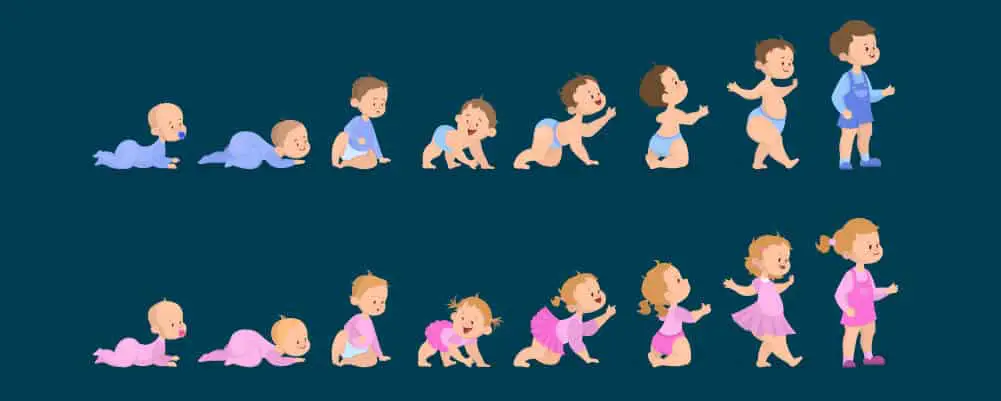
Developmental milestones are behavioral or physical points in the development of your baby as they grow. These are core skills which infants and toddlers should reach over time. These milestones are organized into categories.
The ones that we all consider the most are our gross motor milestones, this is sitting independently, crawling, standing, taking their first steps, and our fine motor skills in the hands and feet such as grabbing objects.
We must also consider sensory milestones, these are things such as visual ability to track objects, obtaining a regular sleep schedule, and the overall development of the 7 senses. Communication is also highly important as a milestone, this includes things such as a baby’s first words, and when a toddler starts responding to questions.
This regards all things in reference to a baby/ toddler/ child’s communication skills. Finally, there are the feeding milestones too, when does a baby stop nursing? When are they ready to have finger foods and more solids in their diet? All these things are considered to be milestones in child development.
Do remember, though, every baby is different. Milestones mark the time when a majority of babies will start showing a certain type of behavior, this can be judged by the typical age at which this happens. However, it will vary. If you are concerned that your baby is not showing a particular milestone, and they are well beyond the point of reaching it, then it is best to contact your healthcare provider.
It is also possible that children can have physical developmental delays or early motor delays. These are terms that describe when children are not meeting critical milestones in the first months and years of life, and therefore affecting how well and soon they can move and interact with their surrounding environment. These lags can be a sign of something more serious, so it is important that you discuss any of these symptoms with a pediatrician.
- Poor head and neck control.
- Difficulties swallowing.
- Clumsiness.
- Muscular spasms.
- Muscle stiffness or floppiness.
- Delayed rolling over, sitting, or walking.
- Speech delay.
- A body posture which is limp or awkward.
While sometimes these things are nothing to worry about, it is wise to contact your doctor and consult them about it so that they can give you the all-clear, it is better to be safe than sorry.
We use developmental milestones as markers. They are used to track the progress in the development of a child against an arbitrary time frame, which allows doctors to check-in and ensure that a child is roughly on track for their age. If they are not, checking for these milestones prove to be a useful key in the detection of any bumps in the child’s development. This is often carried out through mother/child services and pediatricians, then they are monitors in preschool and school term skills assessments.
This means that if a child is not meeting these milestones, the parents and doctor can help to minimize the impact these hiccups can have on the skill development of the child, as well as protecting their confidence. It can even serve as an indicator of any possible future diagnosis that is needed.
These milestones are judged by what is considered to be ‘normal’ for any particular age range, and they can highlight any areas in which a child may be delayed. It is important that you understand that while the development of a child has a fairly predictable sequence, every child develops differently, and their journey through their development is unique to them, the time frames may differ slightly and so not every late or early milestone is a cause for concern, sometimes it is just their individuality shining through.
Your baby will start their journey through these milestones from a very young age, as young as one month old, as they start to grow and become accustomed to the world that they are now living in. No significant milestones really occur within the first month of life, however, once the child hits two months old, things will start to change, and they begin their journey through their development.
For example, at one month they will start making jerky movements with their arms, their head will flop back if unsupported, and their hands will stay as tight fists. They will also prefer the human face to other patterns and may recognize some sounds too. They may start recognizing smells and will dislike rough handling too.
As they grow older, things will get more interesting and your baby will develop quickly. It is true, they really do grow up too fast.
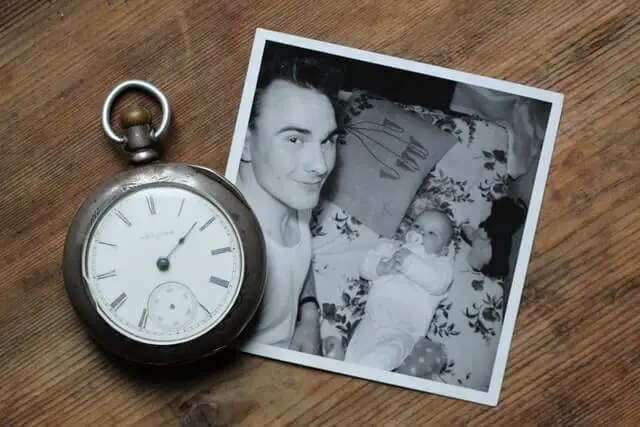
You may be interested in my other articles on Baby Memories:
Baby Handprint and Footprint Keepsakes
Developmental Milestones For Babies

A baby is considered to be younger than one year old, despite not remembering our lives as a baby, this is the time during which we make some of the most important developmental milestones into becoming a functional person.
How your child plays, learns, speaks, acts, and moves will offer important knowledge about how they are developing. Pay close attention to even the smallest thing they do, and you will find yourself watching them grow. They have no other focus at this stage in their life other than growing into the person that they are meant to be. Even the most subtle things they do, that you may not consider to be milestones, are signs of them growing and developing as a new person.
2 Months
By two months old, your baby will already be developing key skills. They will already have 3 social and emotional skills by this age. They will start smiling at people, as their facial muscles grow, and they start to learn what smiling means. Likewise, they will also briefly be able to calm themselves if they need to, this means bringing hands to mouth or sucking on their hand for comfort. Furthermore, they will also start using their eyes more, looking at their parents as well.
They will also have two skills in their language and communication development, even at this young age. They will likely start ‘cooing’ and making gurgling sounds, and they will also recognize sounds, often turning their head to them.
Likewise, a two-month-old will also have three cognitive skills, which include learning, thinking, and problem-solving abilities. You will notice this as they start to pay attention to faces, they will follow things with their eyes and recognize people from a distance. They will also start to act bored, getting fussy, or crying should the activity not change. Different from their first month of life, they will also start to grow stronger and develop their movement and physical skills too. You will notice that they can now hold their head up, and they will also begin to push up when they are laying on their stomach. They will also make smoother and less jerky movements with their arms and legs.
In just two months, they are already making huge strides.
4 Months
By four months, your baby will be making even more progress in their development. At this point they are starting to understand things around them better and may even begin mimicking, they are also starting to understand emotions at this point too.
Socially and emotionally their skills are growing, now they may start smiling spontaneously at people, they will also enjoy playing, and may even start crying when the playing stops. They will also take to copying some movements and facial expressions such as smiling or frowning as well, this is known as mimicking and is how babies learn what facial expressions are and what they mean.
In their communication they will also have made strides, at this point they start babbling, and they may even babble with expressions and copy the sounds that they hear. This may almost seem like they are trying to talk. They will also cry in different ways to convey hunger, pain, or tiredness. As they haven’t mastered language yet, this is their language.
Cognition and movement will be where they have made the most progress, though. In terms of their cognitive abilities, they will start being able to know if they are happy, or if they are sad. They will respond to affection and start reaching for their toys with one hand. They are now learning to use their senses in tandem, seeing an object they want and reaching for it. Furthermore, they will also follow things that move with their eyes and watch faces closely, as if they are trying to understand what they see. Also, they will also start recognizing familiar people even when they are far away.
In their physical development they will be able to hold their head unsupported now, they can push down on their legs when their feet are on a hard surface and begin their journey to strengthen those leg muscles. They can also roll over now, and hold a toy and shake or swing them, such as keys. They can bring their hands to their mouth and when they lay on their stomach they can push up to their elbows. Your baby is getting stronger already!
Between 4 to 6 months old, your baby will also lose the ‘tongue-thrush reflex’ which is important when they are suckling. The loss of this reflex means they can also swallow solid foods, although most pediatricians recommend it is best to leave weaning until they are 6 months old.
6 Months
Your baby is now half a year old, and they are growing fast, as I’m sure you have noticed. Socially, they will now begin to understand familiar faces and know if someone is new or not. They will enjoy playing with others, especially their parents, and they will also respond to other people’s emotions, often seeming happy. Curiously, they will also enjoy seeing themselves in the mirror too.
Their language skills have leapt into action, they will start responding to sounds with sounds, slowly understanding how language works. They will also string vowels together when they babble, such as ‘oh’ or ‘ah’. They may also start to respond to their own name, and make sounds to convey joy or upset. Similarly, they will start making constant sounds such as ‘ma’ or ‘ba’.
In their cognitive development they will start looking around at things near them, they will also start to bring things to their mouth and will show curiosity about new things, making attempts to get to things that are out of reach. They will also begin passing things from one hand to another.
Similarly, they make new developments in the motor skills too, now being able to roll over in both directions; front to back and back to front. They will also now be able to sit without additional support. When they stand, they can now support weight on their legs and may bounce. Furthermore, the child will also start rocking back and forth, you may find them crawling backward before moving forward on occasion.
At this point, your baby may also be able to sit in a highchair, as they start eating soft foods. Make sure they can hold up their head and neck and they are happy to sit here before you do so. Also comply with the safety rules that come with this, always buckle them in.
9 Months
By 9 months old, your baby is really starting to show that they are their own unique person. Socially, they may be afraid and cautious of strangers, possibly being clingy with familiar adults, they will also have favorite toys as well, showing they are now able to make decisions about what they like. In terms of communication they will show signs of understanding ‘no’, and they will also start “talking” more, making sounds like ‘mamamama’ and ‘bababa’, or ‘dadada’. A baby of this age will also often copy the sounds and gestures of others, and has now started using fingers to point at things too.
Cognitively your baby is now growing fast, they will often watch the path of something as it falls, and look for things that you may hide. It is likely that they will also play peek-a-boo and put things in their mouth, almost like this is how they understand things. A child at 9-months will also start moving things smoothly from one hand to another, and they will also start picking up small objects between their thumb and index finger too.
Physically they are also developing well, they can now stand up while holding onto things and can get into a sitting position without any support. At this age, they are also about to pull to stand up and crawl as well.
At 9 months old, your baby can start to manage more complex foods. They may already be showing a preference for certain fruits and vegetables and want to grab and try any food you are eating.
It is also at this time that pediatricians recommend offering them highly allergenic foods, such as peanuts. There is evidence to suggest letting a child under 1-year-old eat peanuts reduces the risk of an allergy developing later, however, stay away from whole nuts, nut pieces, and hard candy as these are choking hazards.
This is also a time when you can start introducing a bit of water into their diets too. Once they start a diet of mostly solid foods, they can also start having water with their meals using a sippy cup. If an older baby shows interest in your water, let them have a few sips but don’t let it replace breastmilk or formula, as this has nutrients they need.
12 Months
By the time your baby is a year old, they are becoming more independent, they may also be more impressionable around this time as well, so you may want to hold off on the cursing.
Socially, a one-year-old may be shy or anxious about strangers, and may cry when their parents leave their sight. They will also have favorite things such as toys, objects, and people, and they may also show fear in some situations. At a year old, they are also likely to hand you a book when they want to hear a story, and make repeat sounds or actions to get your attention. They may also put out their limbs to help you when you are dressing them, and are more likely to enjoy games like ‘peek-a-boo’ and ‘pat-a-cake’.
Your one-year-old is also very curious and will mimic you and try new things. Linguistically, they will respond to spoken requests and start using gestures such as waving or shaking their head. Their speech will also start to use internation and tones, so while they are still babbling it will sound more like speech. They will also start saying ‘mama’ and ‘dada’ as well as exclamations such as ‘uh-oh!’ and so on. It is also very likely that your child will mimic you more, trying to say words that you say.
By this time their cognition is very well-developed, they will explore new things using action such as shaking, banging, and throwing, they will also find hidden objects easily, and they will also poke with their index finger now too. They will also copy the gestures they see from other people, and can now use items such as drinking from a cup and brushing hair. A child of this age will also enjoy putting things places and removing them, and can even follow simple directions such as ‘pick this up’.
Physically, a one-year-old can easily sit without help, and pull to stand, then walk while holding onto furniture, which is known as ‘cruising’. Your baby may also be able to take a few steps without being held alone, and it is even possible that they can stand alone too!
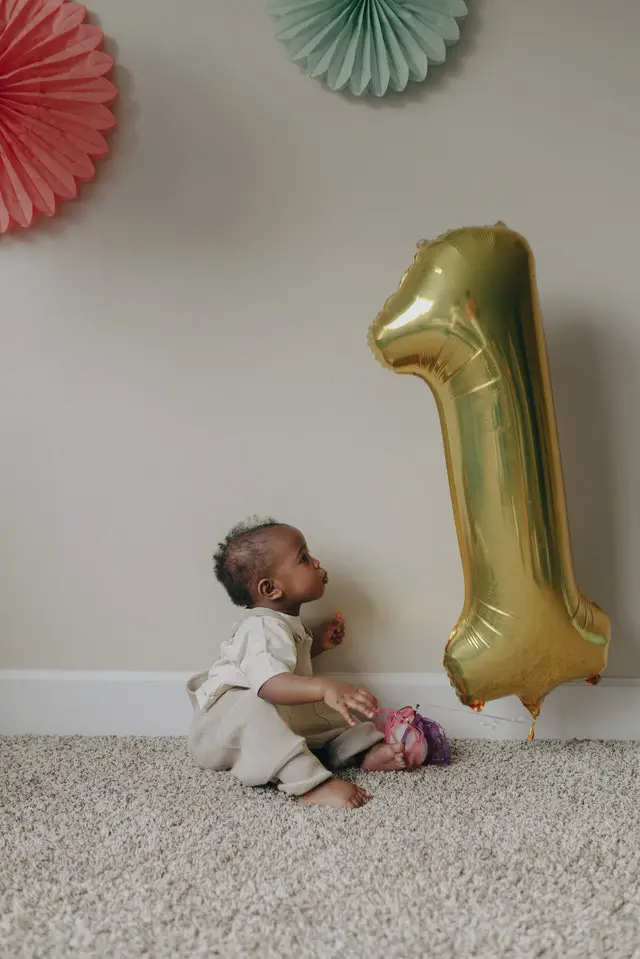
You may be interested in my other articles for One-Year-Olds:
19 Time Capsule Ideas for your Baby’s First Birthday
Developmental Milestones For Toddlers
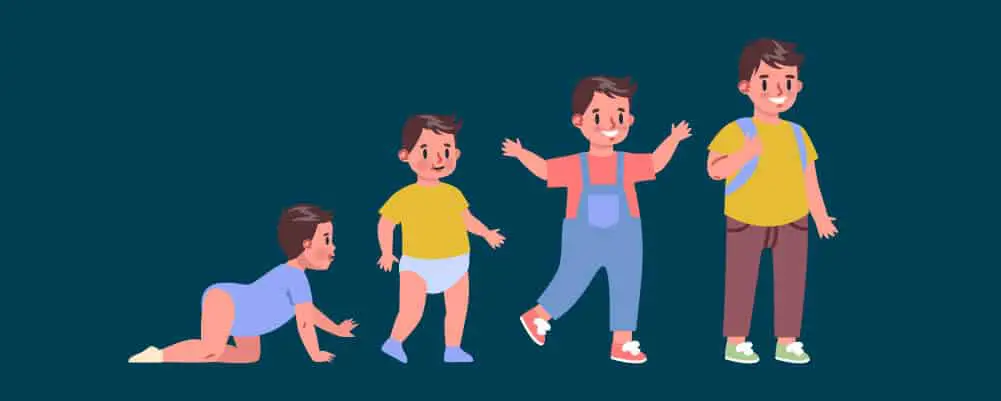
Once your baby is over a year old, they are considered to be a toddler, and now is when they start to grow up very quickly. They will soon go from babbling to speaking, and standing to running. Their milestones will come quickly, and soon they will show their personality for the world to see.
12-18 Months
Once your baby is 18-months old, they are capable of many new things and are growing even faster.
Socially they now enjoy handing things to others as play. However, you may want to expect the odd temper tantrum and some fear of strangers, but they will still be affectionate to familiar people. This is also the time in which your child may start to play pretend and start using their imagination, they may feed a doll or example. Your child may also cling to you in new experiences, and point to show others what they find interesting. Your baby will also enjoy exploring alone, but they still want you close by.
Their language is now starting to bloom, they will start saying several single words at this time, and they will say ‘no’ when they shake their head. If they want something, they will also point to show you, becoming more well versed in communication.
As their language skills develop their cognitive development is zooming ahead, they now recognize objects such as telephones, brushes, spoons, and they can point to get people’s attention. They will also show interest in their favorite toys, and may start scribbling, they may even start to follow simple verbal commands.
Physically they are now able to walk alone, perhaps even run, undress themselves, drink from cups and eat with a spoon! Although a baby at this age can now eat with a spoon, they may try to do so beforehand as well, as practice. When they seem ready to start eating with a spoon, try thick and sticky foods such as yogurt or mashed potatoes. Do expect this to get messy as they learn.
2 Years
At two years old your child is becoming more independent, they will be able to say more, even stringing together sentences, they will be more interested in games with other children, and will enjoy working with shapes and colors. They will now be able to recognize objects and understand what is going on around them more. They have started their path to learning. Here are the milestones you should look out for at 2 years old.
Social/Emotional
- Copying/ mirroring- especially around other children and adults.
- Will be defiant- yes, the terrible twos! Learn how to parent positively HERE.
- Plays beside other children, but will start playing alongside others too.
- Acts much more independent.
Communication/ Language
- Understand names of people and body parts.
- Say sentences with 2 to 4 words.
- Will repeat words they hear (careful of the curse words at this time)
- Will follow simple instructions.
Cognitive abilities
- Uses imagination- playing games.
- Starts to develop a dominant hand.
- Can name things in picture books, such as animals.
- Able to complete sentences or rhymes from books.
- Can follow two-step directions.
Physical ability
- Can tiptoe.
- Can kick balls and run around.
- Is now able to tackle stairs and climb furniture.
- A baby of this age can now generally feed themselves without spilling.
3 Years
At three-years-old your child is now much more like you, they are more linguistically capable, and they will also understand and show more emotions. You will also find they are starting to understand socializing more. Physically they are well-developed, they can now walk up and down stairs like we do and can even ride a tricycle. Creative skills will start to shine as they will use their imagination more, and they will have more understanding with puzzles and an ability to handle doors.
Social/ Emotional
- Understands possession/ possessive words.
- Is more independent of parents.
- Capable of dressing and undressing oneself.
- Shows a wider range of emotions.
- Copies, is affectionate too and has empathy for friends and family.
Language/ Communication
- Wider vocabulary using pronouns, and can use plurals, will also understand words such as ‘on’, ‘in’ and can use sentences.
- Understands their name, age, and gender.
- Can name most familiar objects.
Cognitive ability
- Can work with buttons, levers, moving parts, is able to turn book pages, and can do puzzles with 3-4 pieces.
- Also, capable of screwing and unscrewing jar lids and turning door handles.
Physical ability
- Ability to climb well, run without help, and can even pedal a tricycle and walk up and down the stairs with ease like an adult does.
4 Years
At four-years-old, your child is now even better developed. They will be more imaginative, often confusing reality with make-belief, they, however, will also enjoy the company of other children over solitude. At four, they will also understand storytelling and understand the basic rules of grammar and counting. A four-year-old can also use scissors, understand board and card games, and will be able to count and understand color. They can also hop and stand on one foot, improving their balance. Pour and cut with supervision, and will be able to mash their own food too.
A four-year-old is now becoming an independent and functional member of society.
5 Years
A five-year-old child will have many more skills. They will want to be like their friends and will also want to please them, they will be more likely to stick to rules, and will now enjoy singing, dancing and acting. At this age they are also starting to understand the difference between reality and fantasy, as well as being more independent, however adults are still required to supervise. A five-year-old can also speak clearly and use full sentences, as well as understanding tenses.
A five-year-old can also now write numbers and letters, and will know things about society such as money, and food. Physically, a five-year-old can now take part in sports for their age, they can use swings and climbing frames as well. They are able to use a restroom on their own and can use their own cutlery.
How To Know If Your Baby/ Toddler’s Development Is Normal/ On Track?
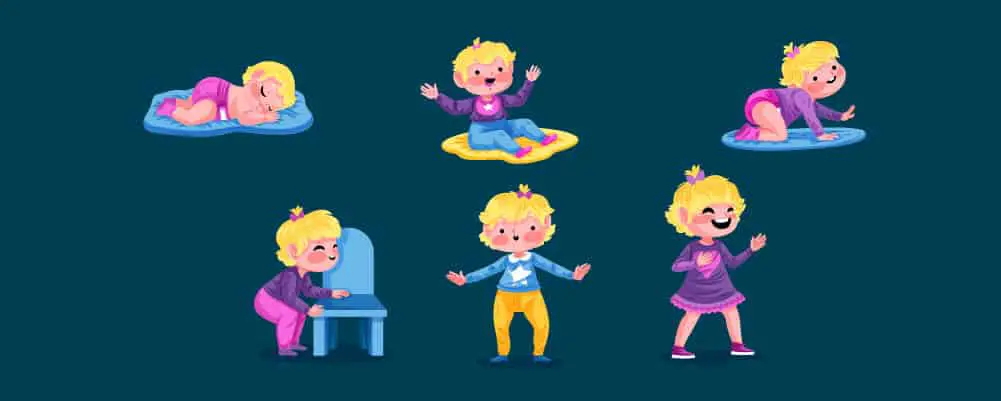
It is important to remember that not every child is the same, and these milestones are basically guidelines, not every child will follow them perfectly, and sometimes they may develop skills a little early, or a little late. However, if they are missing any important skills and there is no sign of them oncoming, then it is best to seek out a doctor. There are a few common concerns for parents about delayed physical development in their child.
- “My child does not seem to be growing as they should be.”
- “My child seems stiff and tight in their movement.”
- “My child is not able to keep up with other children of the same age when they are playing together.”
- “My child seems to get tired very easily.”
- “My child is weak, and limp, much like a rag doll.”
In these cases, if you are concerned you should immediately speak to a doctor. Often, a child who is late blooming will eventually catch up with other children, however it is not unheard of for late blooming to be a sign of a health condition. There are around 400,000 babies born every year in the US alone that have a form of a neuromuscular condition, and 1 in 40 babies can be born with an early motor delay. Spotting these issues early will find any condition as fast as possible and ensure your child gets the care they need. Some conditions may even be preventable if caught early enough.
The important thing is to remember that every baby will develop at a different rate, do not get flustered if your baby has not reached a certain milestone yet, simply take them to see the pediatrician, and they will assess if there is anything to worry about or if your baby is just a late bloomer.
Summary

Everyone goes through milestones in their life, but some of the most important ones we go through are from birth into childhood. As we grow up we learn to walk, talk, speak, understand language, shapes, and the world around us. Our bodies and mind grow, and as they do, we learn new things and build up our strength and senses to become accustomed to this wonderful new world we are a part of.
Your baby will go through these milestones, but every baby is different and will reach them in their own time. Not every baby walks, talks, crawls, or babbles at the same time in their development. But, if you are concerned, talk to your pediatrician for peace of mind and reassurance.

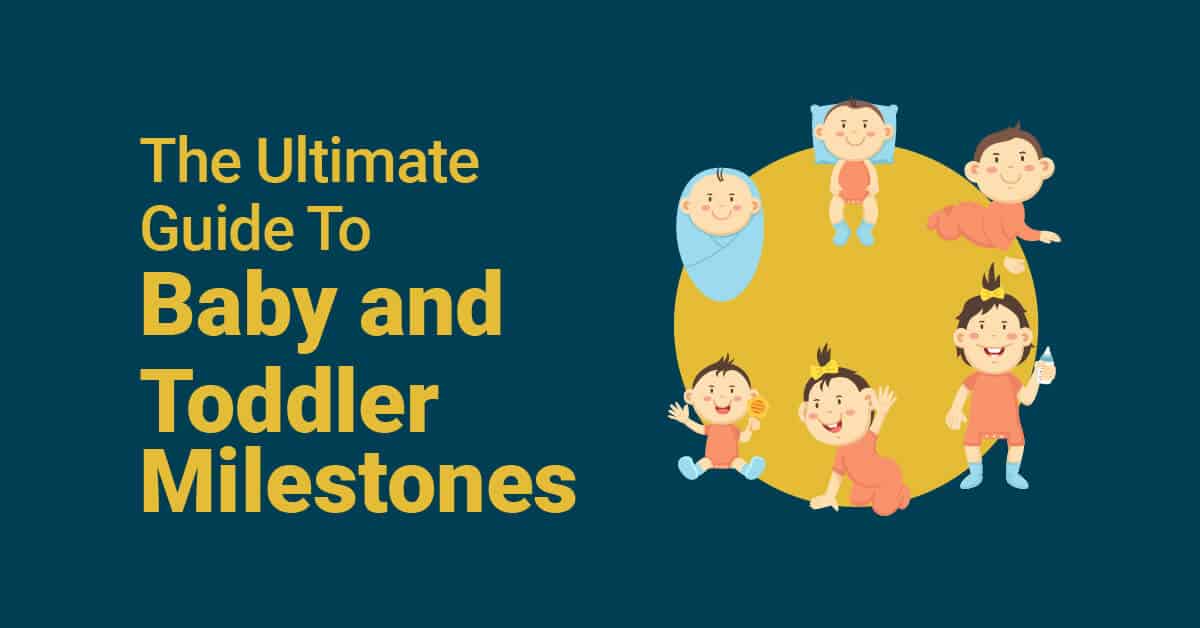
8 comments
Comments are closed.